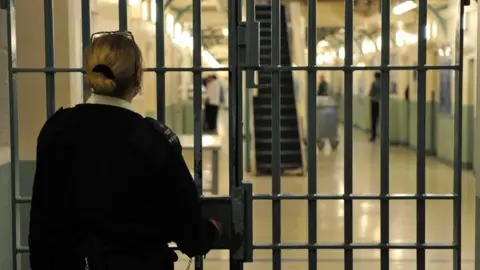Coronavirus: More than 2,000 prisoners may have been infected, says PHE
 BBC
BBCThe number of prisoners believed to have been infected with coronavirus may be up to six times as many as the published figure, it has emerged.
Public Health England (PHE) says it has found 1,783 "possible/probable" cases - on top of 304 confirmed infections across jails in England and Wales.
PHE's report says there have been no "explosive outbreaks" in prisons, but "significant threat levels" remain.
Measures to quarantine new and at-risk inmates are needed for a year, it adds.
The report, published by the Ministry of Justice, says access to testing for prisoners has been "limited and variable".
"Therefore, the number of laboratory confirmed cases reported does not represent the true burden of infection in the prison system," it said.
"During outbreaks, where a number of positive laboratory samples have been received (usually around five or more) on prisoners who have been swabbed, then subsequent cases who meet the clinical case definition are included as 'possible/probable cases'."
Of the 1,783 "possible/probable" cases by the end of last week:
- 398 were in Welsh prisons
- 298 in the West Midlands
- 264 in south-east England
Wales also had more confirmed cases (77) than anywhere else.
PHE said officials had responded to outbreaks in 75 different "custodial institutions", with 35 inmates treated in hospital and 15 deaths.
But the report says the frequency of outbreaks and the number of cases is reducing, indicating that the initial wave of infections is being "contained effectively" - which it says is a "cause for cautious optimism".
Previous modelling suggested there could be between 1,800 and 2,300 deaths, depending on reductions in the prisoner population.
The report goes on to warn, however, that restrictions will be needed until the "end of the financial year", that is April 2021.
"In the absence of a vaccine or effective treatment, risks of large outbreaks in the prison estate will remain.
"These risks may be escalated later in the year relating to relaxation of wider community restrictions, some return of normal police and court activities."
With measures in place, the report estimates there will be 2,800 infections and 100 deaths.

- A SIMPLE GUIDE: How do I protect myself?
- CORONAVIRUS IMMUNITY: Can you catch it twice?
- PUBLIC TRANSPORT: Is it safe to travel?
- WILL I GET PAID IF I CAN'T WORK? The rules on sick pay, wages and time off

One of the measures involves restricting movements of prisoners between jails - known as "compartmentalisation" - in order to stop the "seeding" of infections.
But the report notes that it has been achieved in only a limited way.
It said: "The most effective form of compartmentalisation is single-cell accommodation but it was recognised that this would require significant reductions in prisoner population to achieve across the prison estate (about 15,000 people was the estimate at the time the original advice was provided)."
Earlier, the Commons heard that less than 1% of prisoners eligible for the government's emergency release programme had been freed.
The Justice Secretary, Robert Buckland, told MPs that 33 inmates had been let out, including a number of pregnant prisoners and mothers with babies.
The government originally said up to 4,000 offenders could be released, to create space in jails to help social distancing during the coronavirus outbreak.
